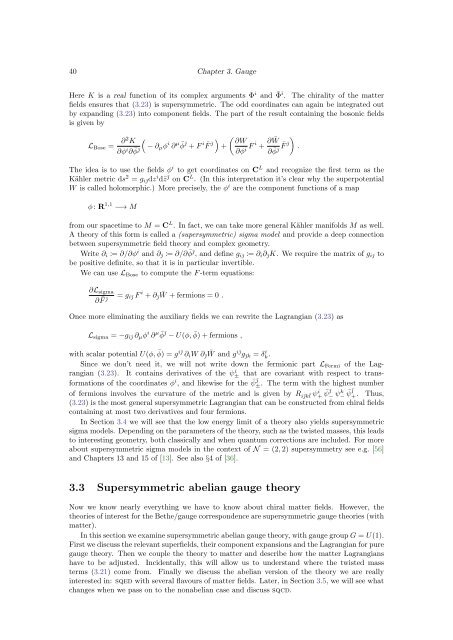The Bethe/Gauge Correspondence
The Bethe/Gauge Correspondence
The Bethe/Gauge Correspondence
You also want an ePaper? Increase the reach of your titles
YUMPU automatically turns print PDFs into web optimized ePapers that Google loves.
40 Chapter 3. <strong>Gauge</strong>Here K is a real function of its complex arguments Φ i and ¯Φī. <strong>The</strong> chirality of the matterfields ensures that (3.23) is supersymmetric. <strong>The</strong> odd coordinates can again be integrated outby expanding (3.23) into component fields. <strong>The</strong> part of the result containing the bosonic fieldsis given byL Bose =∂2 K(− ∂∂φ i ∂ ¯φ¯j µ φ i ∂ µ ¯φ¯j + F i ¯j ¯F ) ( ∂W+∂φ i F i + ∂ ¯W )∂ ¯F ¯j . ¯φ¯j<strong>The</strong> idea is to use the fields φ i to get coordinates on C L and recognize the first term as theKähler metric ds 2 = g i¯j dz i d¯z¯j on C L . (In this interpretation it’s clear why the superpotentialW is called holomorphic.) More precisely, the φ i are the component functions of a mapφ: R 1,1 −→ Mfrom our spacetime to M = C L . In fact, we can take more general Kähler manifolds M as well.A theory of this form is called a (supersymmetric) sigma model and provide a deep connectionbetween supersymmetric field theory and complex geometry.Write ∂ i := ∂/∂φ i and ∂¯j := ∂/∂ ¯φ¯j , and define g i¯j := ∂ i ∂¯j K. We require the matrix of g i¯j tobe positive definite, so that it is in particular invertible.We can use L Bose to compute the F -term equations:∂L sigma∂ ¯F ¯j = g i¯j F i + ∂¯j ¯W + fermions = 0 .Once more eliminating the auxiliary fields we can rewrite the Lagrangian (3.23) asL sigma = −g i¯j ∂ µ φ i ∂ µ ¯φ¯j − U(φ, ¯φ) + fermions ,with scalar potential U(φ, ¯φ) = g i¯j ∂ i W ∂¯j ¯W and g i¯j g¯jk = δk i .Since we don’t need it, we will not write down the fermionic part L Fermi of the Lagrangian(3.23). It contains derivatives of the ψ± i that are covariant with respect to transformationsof the coordinates φ i , and likewise for the ¯ψ¯j ±. <strong>The</strong> term with the highest numberof fermions involves the curvature of the metric and is given by R i¯jk¯l ψ+ i ¯ψ¯j − ψ− k ¯ψ¯l+ . Thus,(3.23) is the most general supersymmetric Lagrangian that can be constructed from chiral fieldscontaining at most two derivatives and four fermions.In Section 3.4 we will see that the low energy limit of a theory also yields supersymmetricsigma models. Depending on the parameters of the theory, such as the twisted masses, this leadsto interesting geometry, both classically and when quantum corrections are included. For moreabout supersymmetric sigma models in the context of N = (2, 2) supersymmetry see e.g. [56]and Chapters 13 and 15 of [13]. See also §4 of [36].3.3 Supersymmetric abelian gauge theoryNow we know nearly everything we have to know about chiral matter fields. However, thetheories of interest for the <strong>Bethe</strong>/gauge correspondence are supersymmetric gauge theories (withmatter).In this section we examine supersymmetric abelian gauge theory, with gauge group G = U(1).First we discuss the relevant superfields, their component expansions and the Lagrangian for puregauge theory. <strong>The</strong>n we couple the theory to matter and describe how the matter Lagrangianshave to be adjusted. Incidentally, this will allow us to understand where the twisted massterms (3.21) come from. Finally we discuss the abelian version of the theory we are reallyinterested in: sqed with several flavours of matter fields. Later, in Section 3.5, we will see whatchanges when we pass on to the nonabelian case and discuss sqcd.
















